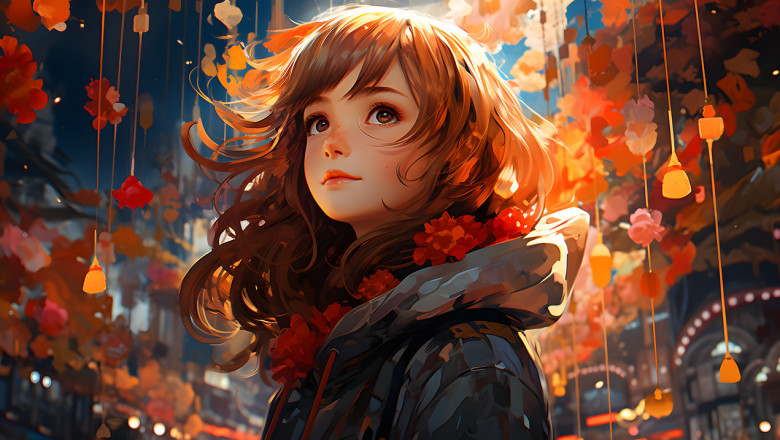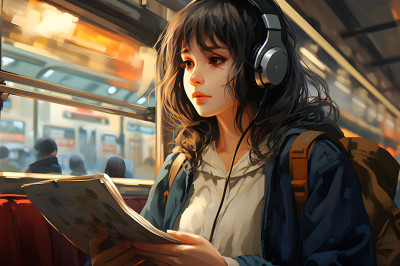Understanding Anime: Origins and Evolution
Anime, a style of animation that originated in Japan, has become a cultural phenomenon with a global reach. Its roots can be traced back to the early 20th century, with the earliest known Japanese animation dating to However, it was not until the post-World War II era that anime began to take the shape we recognize today, influenced heavily by the works of Osamu Tezuka, often referred to as the "God of Manga."
The Distinct Aesthetics of Anime
Anime is characterized by its colorful artwork, fantastical themes, and vibrant characters. The visual style is diverse, ranging from the simplistic and exaggerated to the realistic and detailed. This diversity allows anime to explore a wide array of genres and themes, making it accessible to a broad audience.
Anime Genres and Themes
The world of anime encompasses a multitude of genres, including action, romance, horror, science fiction, and fantasy. Themes often delve into complex issues such as love, morality, and the human condition, often set against elaborate backdrops and storylines. This depth of storytelling has contributed to anime's appeal across different age groups and cultures.
The Global Spread of Anime
The international spread of anime began in the 1960s and 1970s, with shows like "Astro Boy" and "Speed Racer" reaching audiences in the United States and beyond. However, it was the advent of home video in the 1980s and the internet in the 1990s that truly globalized anime, making it more accessible to international audiences.
The Role of Subculture and the Internet
Anime subcultures have played a significant role in its dissemination. Fan communities, both online and offline, share a passion for anime, creating content, organizing conventions, and engaging in discussions. The internet has been instrumental in this, allowing fans to connect, share, and distribute anime-related content across the globe.
Mainstream Acceptance and Influence
Over the years, anime has transitioned from a niche interest to a significant cultural force, influencing mainstream media and entertainment. Blockbuster movies, television shows, and even Western animation have drawn inspiration from anime, incorporating its storytelling techniques and visual style.
Anime's Economic Impact
The global popularity of anime has had a substantial economic impact, particularly in Japan, where it is a major cultural export. The anime industry has seen significant growth, with revenue streams not only from television and film but also from merchandise, video games, and other media.
Merchandising and the Anime Industry
Merchandise plays a crucial role in the anime industry's economy. From action figures and clothing to posters and home decor, the market for anime-related goods is vast and varied. Collectibles, in particular, have become highly sought after, with some items becoming valuable commodities among fans and collectors.
The Rise of Anime Tourism
Anime has also given rise to a new form of tourism, with fans traveling to Japan to visit locations featured in their favorite shows and movies. This "anime tourism" has become a significant source of revenue and has led to the creation of anime-themed events, cafes, and museums.
The Cultural Exchange Through Anime
Anime has not only exported Japanese culture but has also facilitated a cultural exchange. It introduces global audiences to Japanese traditions, societal norms, and historical tales, while also incorporating and adapting to influences from other cultures.
Anime's Role in Cross-Cultural Dialogue
Through its storytelling, anime often addresses universal themes, creating a platform for cross-cultural dialogue. It allows viewers from different backgrounds to find common ground and fosters a greater understanding of diverse perspectives and experiences.
The Influence on Global Art and Entertainment
The aesthetic and narrative influence of anime can be seen in various forms of global art and entertainment. From comic books and graphic novels to video games and cinema, the fingerprints of anime's influence are evident, demonstrating its role in shaping creative expression worldwide.
The Evolution of Anime Merchandise: From Niche to MainstreamEarly Beginnings: Limited Availability and Import Culture
The journey of anime merchandise from obscurity to ubiquity began with the import culture of the 1970s and 1980s. During this era, anime was a niche interest outside of Japan, and fans often had to import VHS tapes and fan-subtitled content to enjoy the latest shows. Merchandise was scarce, typically limited to specialty stores in larger cities or at conventions. These early products were often simple, such as posters, badges, and T-shirts, and were treasured by fans as rare tokens of their favorite series.
The Role of Conventions and Fan Circles
Anime conventions played a pivotal role in the evolution of anime merchandise. These gatherings served as hubs for fans to exchange not only anime itself but also the associated merchandise. Small vendors and fan circles began producing unofficial merchandise, known as "doujinshi," which included art books, apparel, and other handmade items. These fan-made products filled the gap in the market and helped to establish a thriving community around anime collectibles.
Expansion of Official Merchandise
As anime's popularity grew in the 1990s, so did the availability of official merchandise. The success of series like "Dragon Ball," "Sailor Moon," and "Pokémon" led to a surge in demand for related products. Japanese companies began to recognize the potential for revenue beyond the screen and started to license a wider range of merchandise, including action figures, plush toys, and even video games. This expansion was not limited to Japan; international markets also saw an influx of anime products, making them more accessible to a global audience.
Mainstream Retail and Online Shopping
The advent of online shopping revolutionized the anime merchandise industry. E-commerce platforms allowed fans from all over the world to purchase anime products directly from Japan, bypassing traditional retail channels. Simultaneously, mainstream retailers began to take notice of the growing interest in anime. By the early 2000s, it was not uncommon to find anime DVDs, manga, and select merchandise in major bookstores and media outlets, signaling a shift towards mainstream acceptance.
Collaboration with Global Brands and Media Franchises
Anime's crossover into the mainstream was further solidified through collaborations with global brands and media franchises. High-profile partnerships with fashion labels, fast-food chains, and even car manufacturers showcased anime-themed designs and limited-edition products. These collaborations introduced anime to a broader audience and cemented its status as a cultural phenomenon with widespread appeal.
The Impact of Streaming Services and Social Media
The rise of streaming services like Netflix, Crunchyroll, and Hulu has made anime more accessible than ever before, contributing to its mainstream status. With the ease of streaming, new fans are continually being introduced to anime, expanding the market for merchandise. Social media platforms have also played a significant role, allowing fans to share their collections, discover new products, and connect with others who share their interests. Influencers and content creators often feature anime merchandise in their posts, further promoting the items and encouraging sales.
Diversification of Merchandise and the Collector's Market
As the audience for anime has grown, so has the diversity of merchandise available. Today, there is a wide array of products catering to different tastes and budgets, from affordable keychains to high-end collectible figures. The collector's market has exploded, with limited-edition releases and rare items fetching high prices on the secondary market. This diversification reflects the evolving nature of fan engagement, where collecting merchandise has become a significant aspect of the anime experience.
Integration into Pop Culture and Everyday Life
Anime merchandise has transcended the boundaries of fandom to become part of everyday life. It is not uncommon to see anime graphics on clothing, accessories, and even household items in mainstream stores. The imagery and characters have become iconic, often recognized even by those who do not consider themselves fans of anime. This integration into pop culture demonstrates the full extent of anime merchandise's journey from a niche interest to a mainstream staple.
The Psychology Behind Collecting: Why Fans Cling to MerchandiseEmotional Connection and Nostalgia
Collecting anime merchandise often stems from a deep emotional connection that fans develop with a series or character. This emotional bond can be so strong that fans seek to manifest their affection and preserve the memories associated with the anime through physical items. Nostalgia plays a significant role in this process, as collectibles serve as tangible links to the joy and comfort experienced during initial viewings. These items become cherished mementos that can transport fans back to the moments they first encountered the anime, allowing them to relive the excitement and happiness.
Identity and Community
For many fans, anime merchandise is a means of self-expression and identity formation. Collectibles act as outward symbols of their interests, affiliations, and membership within the anime community. By owning and displaying merchandise, fans communicate their passion for a particular series or character, which can facilitate connections with like-minded individuals. This shared interest fosters a sense of belonging and camaraderie among fans, reinforcing their identity as part of a larger, supportive community.
The Thrill of the Hunt
The act of collecting itself can be a driving force behind the accumulation of anime merchandise. The thrill of the hunt, or the excitement and challenge of tracking down rare or limited edition items, can be highly rewarding. For some collectors, the pursuit is as enjoyable as the acquisition, with each new find adding to a sense of accomplishment. This ongoing quest can keep fans engaged with the anime and its related products, as they continuously seek to complete or enhance their collections.
Status and Prestige
Owning a vast or unique collection of anime merchandise can confer a certain level of status and prestige within the fan community. Collectors often take pride in their acquisitions, especially if they include rare, valuable, or autographed items that are difficult to obtain. This can lead to recognition and respect from peers, as well as opportunities to share knowledge and experiences with others. The desire for status can motivate fans to continue expanding their collections and to participate actively in the community.
Psychological Ownership and Control
Collecting anime merchandise can also fulfill a psychological need for ownership and control. Fans may feel a sense of personal investment in their favorite series, and acquiring merchandise allows them to exert a form of control over their fandom. By choosing what to collect and how to display it, fans create personalized spaces that reflect their tastes and preferences. This control over their environment can provide comfort and satisfaction, as the collection becomes an extension of the self.
The Role of Scarcity and Exclusivity
Scarcity and exclusivity are powerful motivators in the world of anime collectibles. Limited edition items and merchandise released in small quantities can create a sense of urgency and desire among fans. The rarity of these items makes them more coveted, as owning something that not everyone can have enhances its value and appeal. This exclusivity can drive fans to act quickly to secure these items, adding to the excitement and engagement with the anime merchandise market.
The Impact of Anime Merchandise on the Entertainment IndustryRevenue Streams and Economic Growth
Anime merchandise has become a significant revenue stream for the entertainment industry. The sale of action figures, apparel, posters, and other collectibles directly contributes to the financial health of anime studios and production companies. This influx of capital has allowed for the expansion of anime projects and increased investment in animation quality and storytelling. The economic impact extends beyond the studios, as licensing deals with manufacturers and retailers also generate substantial income.
Cross-Media Marketing and Brand Expansion
Merchandise plays a crucial role in cross-media marketing strategies. It helps in creating a cohesive brand image across various platforms, including video games, movies, and books. Anime series often extend their reach by offering exclusive merchandise that ties in with narrative arcs or special events within the series, thereby enhancing the overall brand and its presence in the market.
Fan Engagement and Community Building
Merchandise is a tangible way for fans to express their passion for their favorite anime. It fosters a sense of belonging and helps build communities around specific anime franchises. These communities often engage in discussions, fan art creation, and cosplay, further promoting the anime and contributing to a vibrant fan culture that can influence industry trends and the success of future projects.
Influence on Western Markets and Globalization
The popularity of anime merchandise has also impacted Western entertainment markets. It has introduced new aesthetics and storytelling techniques that have influenced Western animation and pop culture. The global demand for anime merchandise has led to increased collaboration between Japanese anime studios and international companies, promoting cultural exchange and the globalization of the anime industry.
Innovation and Product Development
The demand for anime merchandise has spurred innovation within the entertainment industry. Companies are continually developing new products and technologies to enhance the fan experience. This includes high-quality figures with intricate details, augmented reality experiences linked to merchandise, and limited-edition releases that create a sense of exclusivity and urgency among collectors.
Intellectual Property and Legal Considerations
As the market for anime merchandise grows, so does the importance of intellectual property management. Studios and creators must navigate the complexities of copyright, trademarks, and licensing agreements to protect their work and revenue. The proliferation of counterfeit goods also poses challenges, requiring industry-wide efforts to combat piracy and ensure that profits benefit the creators and legitimate stakeholders.
Merchandise as a Cultural Indicator
Anime merchandise serves as a cultural indicator, reflecting the popularity and influence of anime within mainstream media. The types of merchandise that gain popularity can signal industry trends, such as the rise of certain genres or the appeal of particular character archetypes. This feedback loop can inform studios and creators about audience preferences, shaping the direction of future anime productions.
The Role of Exclusive and Limited-Edition Items in Fandom CultureCreating a Sense of Community and Belonging
Exclusive and limited-edition items often serve as a badge of honor within fandom communities. Fans who possess these items are typically seen as more dedicated or hardcore, which can elevate their status among peers. These collectibles can also act as conversation starters, helping fans to connect with one another over shared interests. At conventions, for example, limited-edition merchandise can create a sense of camaraderie among those who have managed to acquire the same rare items.
Enhancing the Fan Experience
Owning exclusive merchandise can significantly enhance the overall fan experience. These items often come with a story; perhaps they were obtained at a special event, or they required a certain level of effort to acquire. This narrative adds an emotional value to the items that goes beyond their physical worth. Fans may feel a deeper connection to the anime or character represented by the merchandise, further immersing them in the fictional worlds they love.
Driving Demand and Hype
The scarcity of exclusive and limited-edition items can create a sense of urgency among fans, driving demand and generating hype. When an anime announces the release of a limited run of collectibles, it often leads to a rush of fans trying to secure their own piece before it sells out. This hype can extend the life of an anime series well beyond its air date, keeping the fandom active and engaged.
Influencing Secondary Markets and Scalping
The high demand for exclusive items often gives rise to secondary markets where these goods are resold at a premium. Scalpers may take advantage of the limited availability to buy up stock and resell it to desperate fans at inflated prices. This can lead to a contentious dynamic within the community, where wealthier fans or those willing to pay scalper prices can obtain items that others cannot afford.
Impact on Industry Trends
Anime studios and merchandise producers closely monitor which exclusive items perform well in the market. The popularity of certain limited-edition collectibles can influence future production decisions, leading to the creation of similar items or the development of merchandise lines for other characters or series. This feedback loop helps the industry to tap into fan preferences and can shape the direction of anime merchandising.
Fostering Collecting as a Hobby
For many fans, collecting exclusive and limited-edition anime merchandise becomes a hobby in its own right. The thrill of the hunt for rare items and the satisfaction of completing a collection can be a significant part of the fan experience. Collectors often take pride in displaying their acquisitions, sometimes dedicating entire rooms or social media pages to showcase their collections.
Encouraging Fan Creativity
The desire for exclusive items can also encourage fan creativity. When official merchandise is limited or too expensive, fans may create their own custom items or modify existing ones to reflect the exclusivity they crave. This DIY aspect of fandom culture not only allows for personal expression but also contributes to a diverse and vibrant fan-made merchandise scene.
Preserving the Legacy of Anime Series
Finally, exclusive and limited-edition merchandise can play a role in preserving the legacy of anime series. Long after a show has ended, the continued circulation and discussion of its rare collectibles can keep its memory alive. These items act as tangible links to the past, allowing new generations of fans to connect with anime classics through the shared experience of collecting.
How Technology and Social Media Have Transformed Anime MerchandisingThe Advent of E-commerce Platforms
The rise of e-commerce has revolutionized the way anime merchandise is bought and sold. Online marketplaces and dedicated e-commerce websites have made it possible for fans to purchase a wide array of anime-related products from the comfort of their homes. This shift has expanded the reach of anime merchandise, allowing fans from all over the world to access goods that were previously only available in Japan or at specific conventions. E-commerce platforms have also enabled independent creators and smaller studios to sell their anime-inspired creations, thus diversifying the market.
On-Demand Production and Personalization
Advancements in manufacturing technology have allowed for on-demand production of anime merchandise. This means that products are created as they are ordered, reducing the need for large inventories and minimizing waste. Furthermore, technology has enabled the personalization of merchandise, giving fans the opportunity to customize their products with their favorite characters or scenes. This level of personalization has deepened the connection between fans and the anime they love, making the fan experience more intimate and unique.
Social Media Marketing and Community Building
Social media platforms have become a crucial tool for marketing anime merchandise. They allow for direct engagement with fans, who can participate in the promotion of their favorite anime through sharing, liking, and commenting. Anime producers and merchandise vendors use social media to announce new products, special editions, and limited-time offers, creating a buzz that can quickly spread across the fan community. Additionally, social media has facilitated the building of communities where fans can discuss their favorite anime, share their collections, and provide recommendations, further driving the demand for merchandise.
The Role of Influencers and Unboxing Videos
Influencers and content creators on platforms like YouTube and Instagram have a significant impact on anime merchandising. They often showcase their latest purchases, review products, and produce unboxing videos that can influence their followers' buying decisions. These influencers have become trusted sources of information for fans looking to make informed purchases. Their endorsement of certain products can lead to increased sales and visibility for specific anime merchandise.
Augmented Reality and Virtual Experiences
Augmented reality (AR) and virtual reality (VR) technologies are beginning to play a role in anime merchandising. AR apps allow fans to see how a piece of merchandise would look in their home before making a purchase. Some companies are also experimenting with VR to create immersive experiences where fans can interact with their favorite anime characters in a virtual space. These technological advancements are not only enhancing the shopping experience but also adding a new dimension to how fans can engage with anime merchandise.
Data Analytics for Tailored Marketing
The use of data analytics in anime merchandising has become increasingly important. By analyzing consumer data, companies can identify trends and preferences within the fan base. This information enables them to tailor their marketing strategies and develop products that are more likely to resonate with their target audience. Data analytics also helps in optimizing inventory levels and predicting which merchandise will be popular, ensuring that supply meets demand.
The Emergence of Digital Collectibles and NFTs
The anime industry is beginning to explore the potential of digital collectibles and non-fungible tokens (NFTs). These digital assets provide a new form of collectible that can be bought, sold, and traded online. They offer unique ownership rights and can include special features such as exclusive artwork or access to digital content. As the technology behind NFTs matures, they may become a more prominent part of the anime merchandising landscape, appealing to fans who are looking for new ways to collect and invest in their favorite series.
The Economic Ripple Effect: From Conventions to Online SalesThe Role of Conventions in Merchandise Sales
Conventions have long been the epicenter of anime culture, bringing together fans from around the world to celebrate their shared passion. These events are more than just gatherings; they are significant marketplaces for anime merchandise and collectibles. Vendors and exhibitors at conventions offer a wide array of products, from limited edition figures to exclusive artwork, often not available elsewhere or released as convention exclusives.
The sales generated at these conventions are substantial, contributing significantly to the overall revenue of the anime industry. The presence of voice actors, creators, and exclusive panels also drives merchandise sales, as fans are eager to purchase memorabilia associated with their favorite series and stars.
Impact on Local Economies
The influx of attendees to anime conventions has a notable impact on local economies. Hotels, restaurants, and other local businesses benefit from the increased traffic, often seeing a spike in revenue during convention weekends. This boost is not limited to the duration of the event; many fans extend their stays to explore the host city, further contributing to local tourism.
Online Sales and Accessibility
The rise of e-commerce has transformed the landscape of anime merchandise sales. Fans who are unable to attend conventions or those seeking items sold out at events can turn to online stores to complete their collections. Online retailers, both official and third-party, have made it easier for fans to access a broader range of products from anywhere in the world.
Online sales platforms have also enabled independent artists and creators to reach a global audience. Through websites like Etsy and Storenvy, these creators can sell their unique, often handmade, anime-related products, contributing to the diversity and richness of available merchandise.
Secondary Market and Scalping
A significant economic ripple effect comes from the secondary market, where collectibles and exclusive items are resold, often at a higher price. Limited edition items and convention exclusives become hot commodities, with scalpers sometimes purchasing products solely to resell them at a profit. This secondary market can be found on auction sites, in dedicated online forums, and through social media platforms.
Licensing and Brand Partnerships
The demand for anime merchandise has led to an increase in licensing agreements and brand partnerships. Companies recognize the value of associating their products with popular anime franchises, leading to a wide range of merchandise, from clothing lines to tech accessories. These partnerships not only generate direct sales but also serve as marketing tools that contribute to the longevity and popularity of anime series.
The Influence on Industry Trends
The merchandise and collectibles market has a feedback effect on the anime industry itself. Popular items can influence the direction of anime series, with creators and producers taking note of what fans are buying. This can lead to the development of new content, spin-offs, or even the revival of older series to capitalize on merchandise sales.
The economic ripple effect of anime merchandise and collectibles is a testament to the power of fan engagement. From the bustling halls of conventions to the digital storefronts online, the sale of these items not only supports the industry financially but also shapes the experiences of fans and the trends within the anime world.
The Future of Anime Merchandise and Its Place in Pop CultureSustained Growth in Global Markets
The anime industry has seen a significant rise in popularity across the globe, and this trend is expected to continue. As streaming services make anime more accessible to international audiences, the demand for related merchandise is also projected to grow. This growth is not just limited to traditional markets like Japan and the United States, but extends to emerging markets in other regions, where anime is gaining a foothold. The future will likely see a diversification of merchandise offerings to cater to these new fans, with products tailored to regional tastes and cultural preferences.
Technological Advancements and Innovation
The integration of technology into anime merchandise is poised to redefine the collectible experience. From augmented reality (AR) that brings figures to life to smart apparel that interacts with mobile devices, the possibilities are vast. The industry is expected to leverage these technologies to create more immersive and interactive products, blurring the lines between physical merchandise and digital experiences. This innovation will not only attract tech-savvy consumers but also offer new ways for fans to engage with their favorite anime.
Expanding Beyond Traditional Merchandise
Anime merchandise is evolving beyond the conventional models, figures, and apparel. The future may see a rise in unconventional products such as themed furniture, home appliances, and even anime-inspired food items. These products will cater to a growing demographic of fans who wish to incorporate their fandom into various aspects of their daily lives, signaling a shift towards a more lifestyle-oriented approach to anime merchandise.
Collaboration and Cross-Promotion
Collaborations between anime franchises and other industries are becoming increasingly common. These partnerships range from high-fashion collections to automotive designs, indicating that anime is becoming deeply ingrained in various facets of pop culture. Future collaborations are likely to become even more ambitious, potentially leading to anime-themed experiences in virtual reality, theme parks, and other entertainment platforms.
Environmental and Ethical Considerations
As consumers become more environmentally conscious, the anime merchandise industry will need to adapt by adopting sustainable practices. This could involve using eco-friendly materials, reducing waste in production, and ensuring ethical labor practices. Fans are beginning to expect transparency and responsibility from their favorite brands, and this will shape how merchandise is produced and marketed in the future.
The Role of Fan Communities
Fan communities have always played a crucial role in shaping the anime merchandise landscape. In the future, their influence is expected to grow even further. Through social media and online platforms, fans can provide direct feedback to manufacturers and creators, influencing product design and availability. Additionally, fan-created merchandise and small-scale production may become more prominent, supported by platforms that facilitate the sale of independent and artisanal products.
Conclusion
In conclusion, the future of anime merchandise is one of growth, innovation, and increasing integration into mainstream pop culture. As the industry adapts to new technologies, expands its product range, and embraces ethical practices, it will continue to offer fans new ways to express their passion for anime. The evolving landscape of anime merchandise is a testament to the genre's dynamic nature and its enduring impact on pop culture.
































